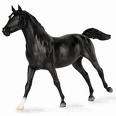Anyone who has owned an older horse, who has no knowledge of their breeding or background and has grown to love that horse, must surely wonder where he or she came from? What did they do in their past? What happened in their lives that shaped their likes and dislikes?
In pre-internet days there wasn't a lot you could do to find out but now we have access to email and on-line searchable databases, it means the horse industry is literally at our fingertips!
If your horse is a particular breed then you may be in luck, try contacting the breed society in your state and hope something turns up. Your horse might have come with a show name or brand which is registered (or was registered in the past), which may reveal his breeding and a little about his history.
If your horse is an ex-racehorse, then you are definitely in luck in your horse is from Australia. You can visit http://www.studbook.aust.com and do a search on his official racing name. It should reveal his sire and dam, his date of birth, racing history and earnings.
For standardbreds, visit http://www.harness.org.au which will give similar info.
If your horse is branded, then you need a good description of that brand. Letters and numbers are clear enough but symbol brands need to be accurately described, copy the brand down on a piece of paper, or take a clear photo when the horse has his summer coat in, or when the area has been clipped.
Most states have brand registries, including some online searchable databases. You can find a comprehensive listing of brand contacts at:
http://www.horsedirectory.com.au
Click on "Horse Resources" in the left hand menu, then "Horse Branding/Brand Marks Identification" which will direct you where to try next.
You can also contact your local EFA branch in your state and check if your horse has been registered in the past. Another good site is at: http://www.horsecouncil.org.au
They have a comprehensive links section, plus a listing of most breed organisations and societies in Australia.
But Say Your Horse is of no Particular Breed
Where do you start your search?
Your first contact should be your horse's previous owner, ask them to tell you everything they know including where they got him/her from. Then you might be able to trace him right back through a succession of previous owners and discover a wealth of info. However people move, change phone numbers and seemingly disappear into thin air. What then?.
One idea is to post on some local horse forums, they usually allow you to upload pictures.
You can also try Yahoo horse groups, if you spread the word far and wide, it just might turn something up ! You'll never know if you don't at least start digging.
If you bought your horse locally and his previous owner can't be contacted or shed any light on his/her background, try putting up notices in local feed merchants, saddle shops and veterinary surgeries, or enquire at the nearest Pony Club.
You might strike it lucky !!
By Samantha J Jane
Samantha writes articles on several subjects including horse health issues, horse riding tips and horse rescue stories. To read more articles please visit our Horse Riding website
Article Source: http://EzineArticles.com/?expert=Samantha_J_Jane
Read More..



